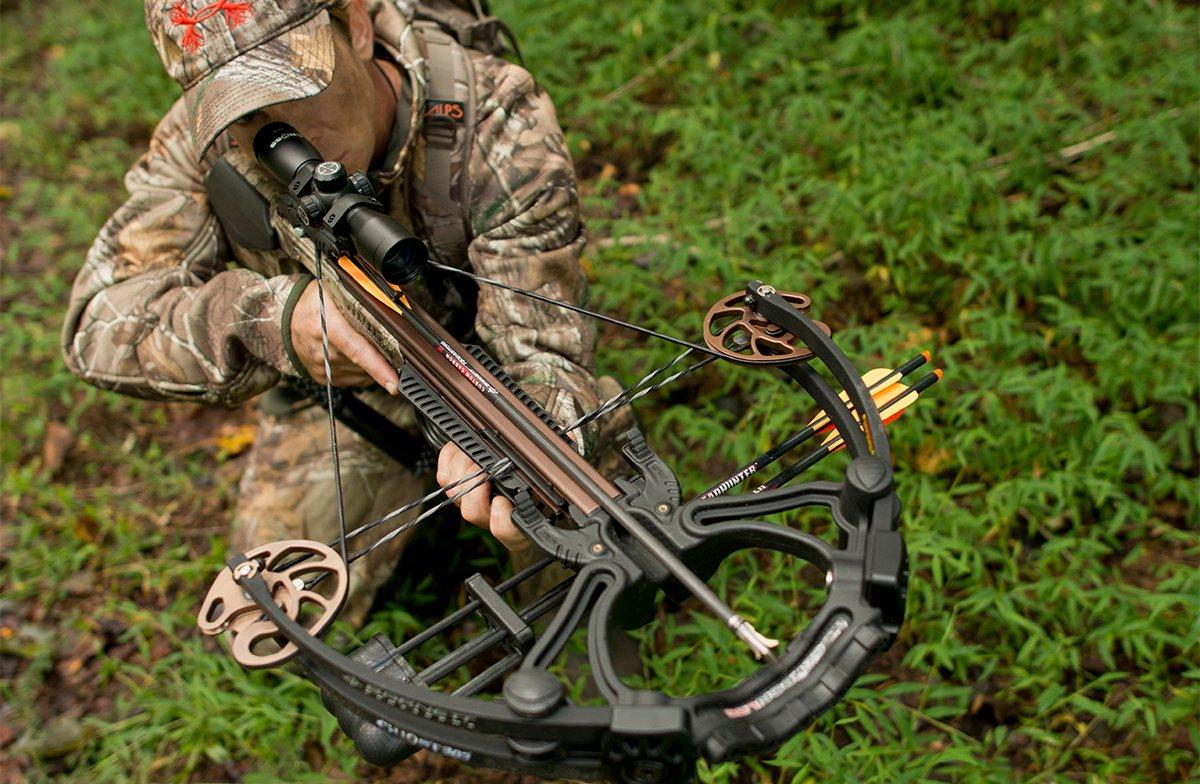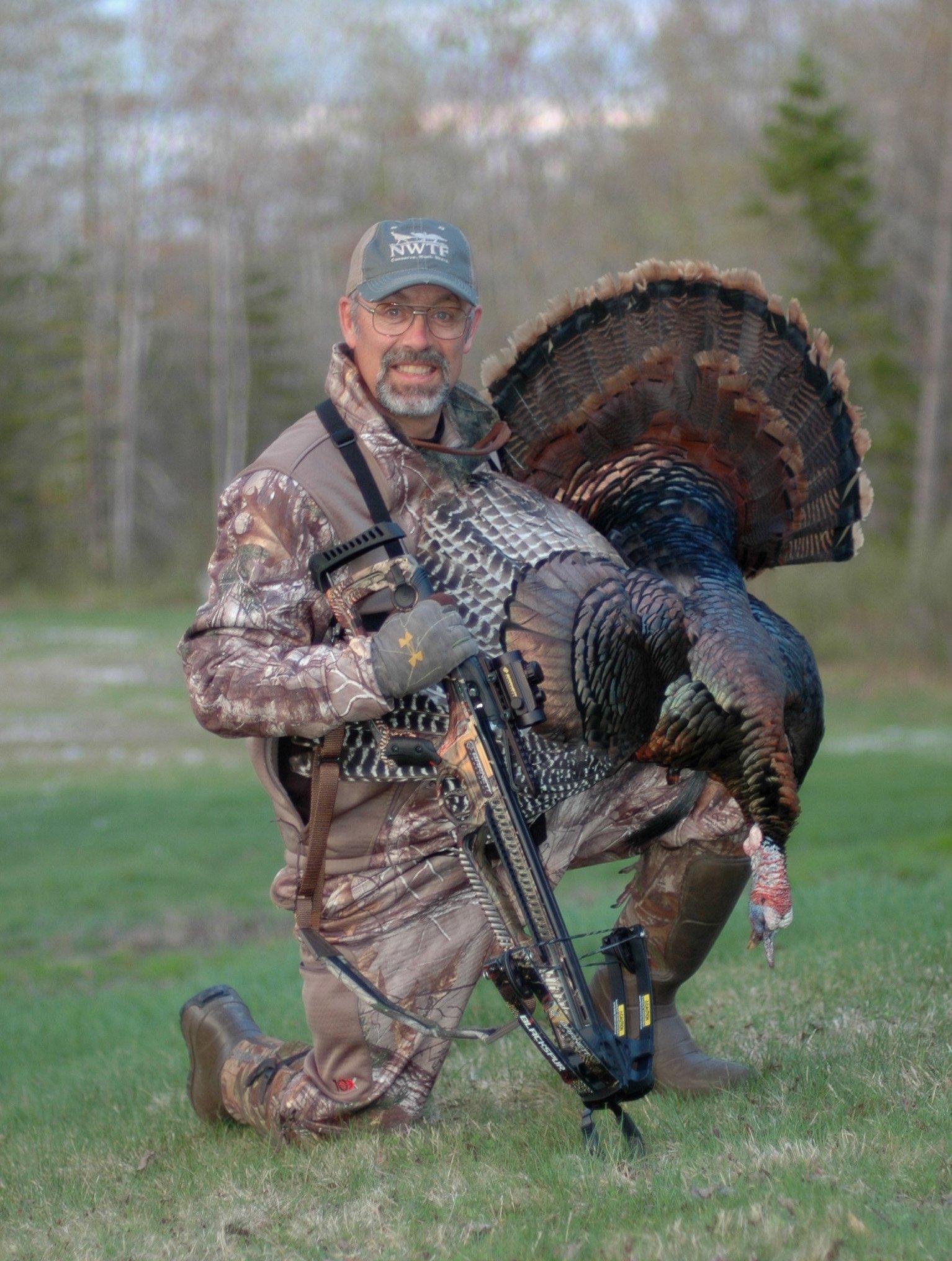Have You Ever Hunted Turkeys with a Crossbow?
Our group was enjoying a midday break in Osceola hunting camp when a couple locals rolled in and struck up a conversation with the camp owner, barely within earshot. I paid little attention until I heard a name, then spun around and asked, Marvin? Marvin Hartley? At the same time I recognized the friend I'd made years earlier, and hadn't seen since. What are the chances? I thought, to meet again under such a surprisingly similar situation. Then again, improbability seemed to be a recurring theme surrounding the circumstances of our previous encounter.
Ten years earlier I set out to record the first official Grand Slam with a crossbow. It began as something of a lark, but took on a more serious tone as the pieces started falling into place. I knew a single-season Slam with short-range tackle would be a daunting challenge with a rather low probability of success. But isn't that what makes such things worth doing?
Plan A, B, C....
The first step, setting up logistics, was not without its challenges. Calling in some favors produced the typical first leg: an Osceola hunt. Characteristically long odds prompted a back-up plan as well - the hunt with Hartley - which would ultimately prove fortuitous.
Peter Brown of Extreme Dimension game calls helped defray some of the costs and provided camerman Scott Underhill to record the quest, and connected us with Wyoming guide Scott Shreve for our Merriam's hunt. Industry contacts helped with a couple Rio hunts and I sort of took Easterns for granted, a decision I would come to regret.
Let the Games Begin
Underhill and I kicked off the quest outside Yeehaw Junction, Florida, and the difficulty factor was emphasized when all the other (gun) hunters tagged out while we had nary an opportunity. The pressure was already building.
Fortunately, Hartley had arranged exclusive access to some prime ground in the Jacksonville area for our second attempt. A quick afternoon tour of the property whet our appetites, but the following morning's near freezing temperatures cooled more than our enthusiasm. And when daybreak failed to yield so much as a gobble, we hoped it was due to the weather rather than a lack of birds.
Just the same we kept calling and were soon rewarded with distant gobbles from several directions. Though still a ways off the birds seemed interested. Thus, I was taken off-guard when Scott whispered, Don't move. Longbeard, 40 yards away. He'd come in silently, on my blind side and was now approaching our decoys. All I could do was ease my bow up and wait.
When the bird came into view he was in range and on a quick trot. I followed him as best I could until he stopped, then instantly centered on his vitals and squeezed the trigger. I held my breath as I watched the bird first run, then slow, then drop. One down!
With a couple more days to burn we took a more casual approach. Hunting a different location some distance to the north we managed to lure in another silent bird that would ultimately play a key role in our objective.
Gone to Texas
We started the next leg outside Eldorado, Texas, but the normally naive Rios were reticent and tough. Several birds came within shotgun range, but never offered a clear opportunity with the bow, so Scott and I headed the rental car toward Cotulla and the Herradura Ranch. The long ride gave me time to think about the pattern of coming up short on the first hunts, the lack of a back-up plan for the Merriam's hunt and no firm plans for Easterns. One step at a time, I rationalized.
The second half of Phase 2 didn't start well either. Guide John Beckett had set a ground blind for us, but the hunt host appropriated that for himself at the very last minute. Instead, we'd have to find our way through unfamiliar territory in the dark, then build a makeshift blind from natural vegetation good enough to conceal both crossbow hunter and cameraman. I was pretty hot by the time we finally managed to cut and pile barely enough thorny mesquite branches to conceal us.
Gobbles coming from three different directions assuaged me and before long birds were pitching down and assembling on the far end of the pasture. We watched several hens and three strutters mill around then fade into the woods. They'd barely disappeared when two more toms sounded off behind us and shortly thereafter popped into the pasture and started our way.
The crossbow made it tough but the camera added yet another impediment. As the birds drew closer I whispered instructions to Scott, Stay on the strutter, he's the biggest bird. But at the last second, the birds switched positions. Switch birds. Switch birds!, I hastily whispered.
I got him, was all I needed to hear before settling the 20-yard red dot on the bird's mid-section and squeezing the trigger. The arrow hit home and the bird stumbled, ran then fell. We ticked another off the list and I added a bonus bird the following day. Two down....
Wild, Wild West
The relief of having two out of four subspecies in the bag was neutralized by anxiety over a three-day Merriam's hunt in Wyoming with no back-up plan, and as yet unmade plans for the final Eastern hunt. Things would have to go perfectly from now on, and that prospect wasn't looking real good.
First, there was an hour weather delay in our flight. Then our bags got offloaded to reduce weight. After a bumpy ride we arrived in Sheridan to 30-degree temperatures and 30-knot winds blowing snow sideways! We waited up half the night for our bags before getting a brief and restless few hours sleep.
The spring snowstorm continued into the morning, much of which we spent sitting in the truck or hiding in an old barn, watching roosted birds endure the maelstrom. The rest we spent slogging through knee-deep snow, futilely calling into the unyielding wind and extracting the truck from snowdrifts.
There was a sliver lining. First, the sun finally melted the snow. Anticipating the turkeys would roost in the same place we built a ground blind and, just as the sun was setting, watched several hens and jakes, and two longbeards fly to roost.
Roosted ain't roasted, but we figured at least one of these birds would be in hot water the following morning. Scott and I arrived with ample time to slip into our blind under cover of darkness and wait out the dawn chorus that soon erupted began around us. Before long birds pitched down and all looked good until the whole group turned and started directly away. Shoulda known, I cursed under my breath. It was just too easy.
I was already working on our next move when I saw the birds heading back our way, and fast. Battle stations: bow up on the sticks, head on the stock, key in on the strutter. I was momentarily mesmerized by his appearance, the stark white band contrasting sharply against his black tail feathers, body feathers ablaze in the new sunlight. The trance was broken by a harsh whisper from Scott. Which bird? Both were now in strut and drawing closer together. And just as the Texas birds had, they swapped places at the worst possible moment. Switch. Switch to the bird on the right I whispered, as softly yet urgently as I could. Instinctively, my pin settled on the bird's mid-section and the shot went off. A fraction of a second later the arrow struck my first Merriam's and the third of my four Slam birds.
Head East
To that point we'd beat the odds but they were about to catch up with us in a big way. With no other offers or opportunities, we settled on a long-shot hunt in Ohio, at the time one of only six Eastern wild turkey states that allowed crossbows. Odds got even longer when we learned our host's nephew, who was supposed to be scouting for us, used the time and access not only to scout but also to fill his own tags. After four fruitless days we re-scheduled our flights and extended our hunt for another two, with still no results. Deciding not to throw good money after bad, we packed up and headed home in defeat. We'd come so close.
After licking my wounds and moping around for several days a thought suddenly popped into my head and a quick phone call to Karen Cavender who manages the National Wild Turkey Federation's Wild Turkey Records gave me the answer I had hoped for. Because of the location where I killed my second Florida bird, it was not an Osceola but an Eastern. I had actually completed the first crossbow Grand Slam in history when I bagged that beautiful Merriam's. And after the forms were sent in to the NWTF it became official.
5 Crossbow Tips for Turkeys
1) Take a Rest - You've got to let the birds get close, and then you can't move, so you'll want a solid rest for your bow. A knee may be suitable in some circumstances but a monopod, bipod or tripod are progressively better options.
2) Think Expandable - Expandable broadheads are better for turkeys. They fly like field points making them easier to tune, and the larger cutting diameter is advantageous for the smaller vital area.
3) Bigger is Better - As long as you're going with expandable or mechanical heads, get the largest cutting diameter you can find, for the above-stated reason. Any associated loss of energy will be negligible with today's high-speed bows and larger cutting area may reduce the likelihood of complete pass-through, which means the head will continue cutting should initial impact not be lethal.
4) Be Patient - Your inclination, particularly if new to bowhunting turkeys, will be to shoot quickly but don't. Turkeys move a lot, and quickly, particularly when nervous. Wait until your target is stationery before taking a shot.
5) Use a Rangefinder - Remember, a crossbow is a bow, not a gun. It's a short-range weapon with a very arced trajectory and short distances can make big differences in where you should aim.
Editor's note: This Realtree.com post was first published April 12, 2017.
Go here for more Realtree turkey hunting. Follow us on Facebook.








